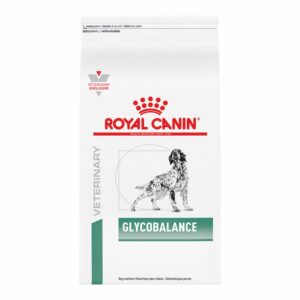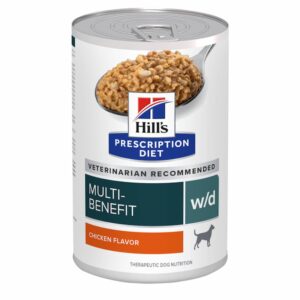Diabetic Dog Food: What to Know

All featured products are chosen at the discretion of the GreatPetCare editorial team and do not reflect a direct endorsement by the author or reviewer.
Diabetes is a medical condition marked by the body not being able to process sugar normally. While it is common in humans, diabetes can also affect dogs. Like humans, pets who are older and overweight are at a higher risk for diabetes.
Being a pet parent to a dog with diabetes is not passive. A diabetic dog treatment plan involves diet, exercise, and insulin administration. Management of diabetes requires constant monitoring, as blood sugar levels that are too high or too low can create real dangers.
That, of course, can make mealtimes difficult to navigate. Not only is it important to feed the right type and amount of food, but you also need to properly time your dog’s meals.
Naturally, you may be wondering whether your dog needs a diabetic dog food formula to help manage their condition or if you can keep feeding their regular food. Here is what you need to know.
Our Top Picks
What to Feed a Diabetic Dog

For dogs with diabetes, diet and nutrition are an important part of their disease management and treatment plan. Feeding the wrong diet or giving dogs table scraps or high-calorie treats can have a negative impact on their health.
“If [your diabetic dog] eats food that is high in carbohydrates, then their blood sugar will be harder to control and often elevated, which can lead to diabetic complications,” explains Dr. Sarah Wooten, a veterinarian based in Colorado.
These complications are numbered and can vary in scope, but can include “extreme weight loss, blindness from cataracts, dehydration, repeated skin or urinary tract infections, and liver disease,” says Dr. Wooten.
So can a diabetic dog eat regular food? The answer is yes, with some caveats. Many dogs diagnosed with diabetes can stay on their same diet—so long as they are working with a veterinarian for guidance and it’s a high-quality maintenance diet (without any high-carbohydrate treats!). Veterinarians mostly focus on regulation of a dog’s diabetes through insulin, portion control, and weight loss, if that’s an issue, Dr. Wooten says.
Work with your veterinarian to ensure your dog’s current food is lower in carbohydrates and higher in both fiber and protein. That being said, the food should not have radically high levels of protein (it should not exceed 40 percent).
If your dog’s current diet isn’t appropriate, your veterinarian may recommend switching to a prescription diabetic dog food.
What Is Diabetic Dog Food?
Diabetic dog food is specifically formulated for dogs diagnosed with diabetes, crafted with your pet’s blood sugar levels and nutritional needs in mind.
“Diabetic dog foods have three goals in mind,” says Dr. Natalie Marks, a veterinarian at VCA Blum Animal Hospital. “They aim to lower the rise in blood sugar dogs get after eating by containing low glycemic index carbohydrates, they have extra sources of fiber to help dogs feel more satisfied and also maintain weight, and they are typically higher in protein and lower in fat for easier digestion.”
Diabetic dog foods offer numerous benefits and very few drawbacks, other than cost.
Best Diabetic Dog Foods
If you are looking for the best diabetic dog food, know that there are not that many prescription diets to choose from. Here is a closer look at two popular choices:
Royal Canin Glycobalance Dry Dog Food

Royal Canin is one of the most widely respected dog food brands around, and they continue to be a go-to for veterinarians. The brand’s diabetic dry dog food, Glycobalance, is specially formulated to control glucose levels and help your dog maintain a healthy weight. This prescription food is also high in protein and contains 49 percent less starch than Royal Canin’s other adult food formulas. These factors all make it an ideal choice for diabetic dogs.
Key Benefits
- Veterinary recommended and prescribed
- Specially formulated to help manage blood glucose levels
- High protein content that helps maintain weight and muscle mass
- Also available in a wet food option to fit your dog’s preferences
Hill’s Prescription Diet w/d Multi-Benefit Dog Food

Hill’s dog food formulas are a staple in most veterinary practices. The brand’s W/D Multi-Benefit Veterinary Diet features L-carnitine to aid in fat metabolism and soluble and insoluble fiber to help control glucose levels. Plus, this dog food offers other benefits to support digestive and urinary health and weight management. It’s a great option if your diabetic dog struggles with digestive and/or urinary issues.
Key Benefits
- Trusted and recommended by veterinarians
- Helps manage multiple conditions, including digestive issues, urinary health, and weight along with diabetic-related glucose maintenance
- Features L-carnitine to aid in fat metabolism, helping dogs maintain weight
Non-Prescription Diabetic Dog Food
While prescription diets are Dr. Marks’ first choice, because they are “tested for optimum health of diabetic patients,” she does offer guidance for pet parents who prefer over-the-counter options.
Non-prescription foods for diabetic dogs should meet the following criteria:
- Low carbohydrate index (dry matter of 25 percent)
- Low glycemic index carbs on the ingredient list, like soybeans, and avoid potatoes
- L-carnitine, which helps with fat metabolism
- Higher fiber content than regular dog foods. Fiber content should be 10-20 percent if your dog is an overweight diabetic or 5-15 percent if your dog is at a normal weight
If you find a non-prescription dog food that seems like a good fit for your diabetic dog, discuss it with your veterinarian. Your vet knows your dog’s history and will be able to guide you along the way.
Diabetic Dog Food: Other Tips and Advice
When switching dog food, introduce the new formula slowly and monitor your pet for any adverse reactions (as you would with any dietary change). You should also closely monitor your dog’s glucose levels on a new diet to ensure the food isn’t causing spikes.
And, of course, you should never introduce a new diet without talking with your veterinarian first. “The most important first step is a conversation with your veterinarian and a physical exam and diabetes assessment for your pet to ensure the best diet for your pet’s medical history,” Dr. Marks says.
Equally or perhaps more important than the type of food is the timing of your dog’s meals and portion control, Dr. Wooten reiterates. It is important to feed a diabetic dog at the same time every day and properly time their feeding around insulin injections for the best blood sugar control.









